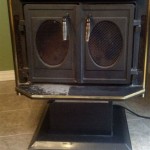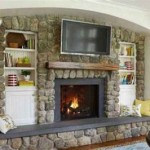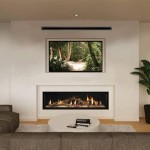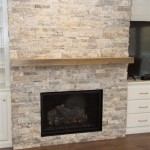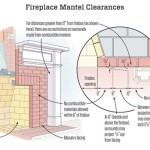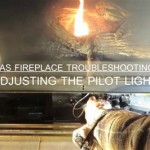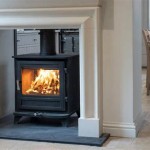Understanding Outdoor Fireplace Gas Logs: A Comprehensive Guide
Outdoor fireplaces offer a compelling blend of ambiance and functionality, extending living spaces and enabling year-round enjoyment of patios, decks, and gardens. At the heart of many such outdoor fireplaces lie gas logs, providing a convenient and visually appealing alternative to traditional wood-burning fires. This article examines the intricacies of outdoor fireplace gas logs, covering their types, installation considerations, maintenance requirements, safety precautions, and aesthetic qualities.
The transition from wood-burning fireplaces to gas-fueled options has been driven by several factors, including environmental concerns, convenience, and regulatory restrictions. Gas logs eliminate the need for sourcing, storing, and handling firewood, while also producing significantly fewer emissions. Furthermore, the consistent heat output and ease of ignition contribute to a more user-friendly experience.
Choosing the right gas logs for an outdoor fireplace is crucial for optimal performance and visual appeal. Factors to consider include the size of the fireplace, the desired aesthetic, the type of gas available (natural gas or propane), and the BTU rating of the logs and burner system.
Types of Outdoor Fireplace Gas Logs
Gas logs are broadly categorized into two main types: vented and vent-free (also known as ventless). Each type operates differently and presents distinct advantages and disadvantages. Understanding these differences is essential for selecting the appropriate gas logs for a specific outdoor fireplace setup.
Vented Gas Logs: These logs are designed for use in fireplaces with fully functional chimneys or vents. They produce a more realistic flame appearance and greater radiant heat, mimicking the look and feel of a wood-burning fire. Vented gas logs require a constant supply of fresh air to support combustion, and the chimney serves to exhaust the byproducts of combustion. While offering superior aesthetics, vented gas logs are less efficient than vent-free options, as a significant portion of the heat generated is lost through the chimney. They are primarily intended for visual appeal and ambiance rather than efficient heating.
Installation of vented gas logs necessitates ensuring proper chimney draft and ventilation. A properly functioning chimney is crucial for preventing the accumulation of carbon monoxide and other harmful gases. Regular chimney inspections and cleaning are recommended to maintain optimal performance and safety.
Vent-Free Gas Logs: Also known as ventless gas logs, these logs are designed for use in fireplaces without a functional chimney. They burn significantly cleaner than vented logs and are equipped with an Oxygen Depletion Sensor (ODS) that automatically shuts off the gas supply if the oxygen level in the room drops to an unsafe level. Vent-free gas logs are more efficient than vented logs, as they radiate more heat into the surrounding area. However, they produce a less realistic flame appearance and can potentially contribute to indoor air quality issues if not properly installed and maintained.
Local regulations often dictate whether vent-free gas logs are permitted for indoor or outdoor use, and adherence to these regulations is paramount. Vent-free gas logs are typically equipped with safety features such as the ODS to mitigate the risks associated with incomplete combustion. Regular maintenance, including cleaning the burner and ensuring proper ventilation, is essential for safe and efficient operation.
The choice between vented and vent-free gas logs depends on individual preferences, budget considerations, and the specific characteristics of the outdoor fireplace. Vented logs offer a more authentic fire experience but require a functional chimney and are less energy-efficient. Vent-free logs provide greater heating efficiency and can be used in fireplaces without chimneys, but may produce a less realistic flame and require careful monitoring of indoor air quality.
Installation and Safety Considerations
Proper installation is paramount for the safe and efficient operation of outdoor fireplace gas logs. Incorrect installation can lead to gas leaks, carbon monoxide poisoning, and fire hazards. It is strongly recommended to engage a qualified professional to install gas logs and ensure compliance with local codes and regulations.
Gas Line Connection: Connecting the gas logs to the gas supply requires meticulous attention to detail. The gas line must be properly sized, properly sealed, and pressure-tested to prevent leaks. A shut-off valve should be installed near the fireplace to allow for easy shut-off in case of emergency. The type of gas (natural gas or propane) must be compatible with the gas logs, and the appropriate regulator must be used to maintain the correct gas pressure.
Placement of Logs: The logs must be placed according to the manufacturer's instructions to ensure proper airflow and combustion. Overcrowding the burner or blocking the vents can lead to incomplete combustion and the production of carbon monoxide. The logs should be arranged to create a visually appealing flame pattern while allowing for sufficient space around the burner.
Ventilation: Adequate ventilation is crucial for preventing the accumulation of carbon monoxide, especially with vent-free gas logs. The area around the fireplace should be well-ventilated, and a carbon monoxide detector should be installed nearby to provide early warning of dangerous levels. Regular monitoring of carbon monoxide levels is recommended, particularly during initial use and after any maintenance work.
Safety Precautions: Always follow the manufacturer's instructions for lighting and operating the gas logs. Never leave the fireplace unattended while it is burning. Keep flammable materials away from the fireplace. Ensure that children and pets are supervised near the fireplace. Regularly inspect the gas logs and burner for signs of damage or wear. Schedule annual inspections by a qualified technician to ensure that the fireplace is operating safely and efficiently.
Before initial use, it is recommended to perform a leak test on all gas connections using a soap and water solution. Apply the solution to the connections and look for bubbles, which indicate a leak. If a leak is detected, immediately shut off the gas supply and contact a qualified technician for repair.
Understanding and adhering to safety guidelines is essential for minimizing the risks associated with outdoor fireplace gas logs. Regular maintenance, proper installation, and vigilant monitoring are crucial for ensuring a safe and enjoyable fireplace experience.
Maintenance and Longevity of Gas Logs
Proper maintenance is essential for extending the lifespan of outdoor fireplace gas logs and ensuring optimal performance. Regular cleaning and inspection can prevent the buildup of soot and debris, which can affect flame quality and efficiency. Neglecting maintenance can lead to costly repairs and potentially hazardous conditions.
Cleaning: Over time, gas logs can accumulate soot and dust, which can diminish their visual appeal and affect their ability to radiate heat. To clean gas logs, first, ensure the gas supply is turned off and the logs are completely cool. Use a soft brush or vacuum cleaner with a brush attachment to remove loose debris. For stubborn stains, a mild detergent solution can be used, but avoid harsh chemicals or abrasive cleaners, as these can damage the logs. Rinse the logs thoroughly and allow them to dry completely before reinstalling them.
Burner Maintenance: The burner is a critical component of the gas log system and requires regular cleaning to ensure proper gas flow and combustion. Use a wire brush or compressed air to remove any debris from the burner ports. Inspect the burner for signs of corrosion or damage, and replace it if necessary. Ensure that the burner is properly aligned and securely attached to the gas line.
Inspection: Regularly inspect the gas logs and burner for signs of damage, such as cracks, chips, or corrosion. Replace damaged components immediately to prevent gas leaks or other safety hazards. Check the gas line for leaks and ensure that all connections are secure. Inspect the chimney or vent for obstructions and ensure that it is properly functioning.
Professional Servicing: Schedule annual inspections by a qualified technician to ensure that the gas log system is operating safely and efficiently. A technician can perform a thorough inspection of all components, including the gas line, burner, logs, and chimney, and identify any potential problems. Preventive maintenance can help extend the lifespan of the gas logs and prevent costly repairs.
Storage: During periods of infrequent use, it is recommended to cover the outdoor fireplace to protect the gas logs from the elements. This can help prevent the buildup of moisture and debris, which can contribute to corrosion and damage. If the gas logs are removed for storage, store them in a dry, protected location.
By adhering to a regular maintenance schedule, owners can maximize the longevity and performance of their outdoor fireplace gas logs, ensuring years of enjoyment and safe operation. Proper care and attention will help preserve the aesthetic appeal and functional efficiency of the gas log system.

36 Outdoor Gas Fireplace Electronic Ignition Fine S

Napoleon Riverside 42 Clean Face Outdoor Gas Fireplace Natural The Professionals

Outdoor Giant Timbers 24 Concrete Vent Free Gas Log Set With Mega Flame Burner Mnf24o Lmf24gta B F2099a F2099b F2124

Gas Logs Vs Wood Burning Outdoor Fireplaces Green Okie

Outdoor Lifestyles Courtyard Gas Fireplace Fireside Hearth Home

Outdoor Gas Fireplace Options And Ideas

The Outdoor Greatroom Company Cf 1224 Log Set Gas Fireplace

42 Inch Vesper Outdoor Gas Fireplace Fine S

White Mountain Hearth By Empire Ventless Premium Outdoor Gas Firebox 42

Outdoor Gas Fireplaces Landscaping Network

